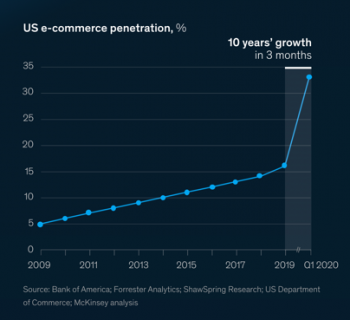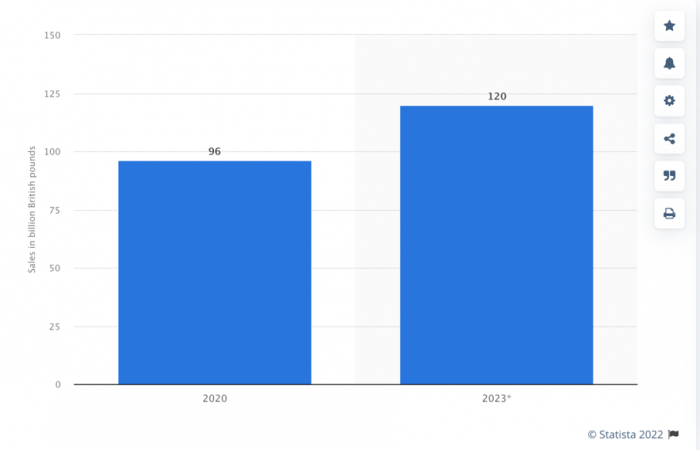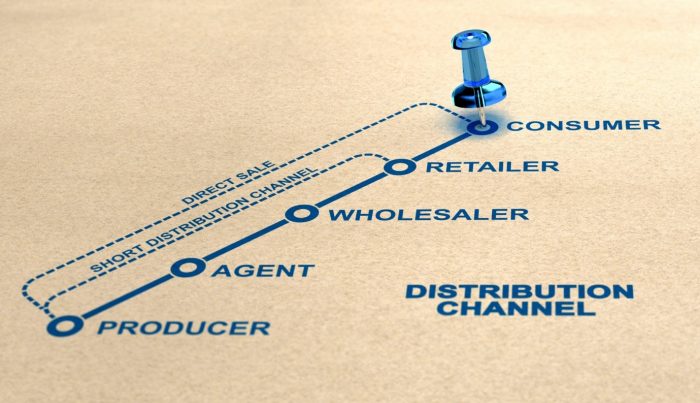
According to McKinsey, 10 years of e-commerce growth occurred in just 90 days in 2020.

None of us can forget that in 2020 the pandemic hit and we experienced a purchasing shift from traditional brick-and-mortar stores to e-commerce brought about by the global population being ‘grounded’ at home. Consumers quickly adapted to purchasing groceries and other traditional bricks-and-mortar items online.
In the traditional sales model, retailers had the greatest impact on — and arguably owned — the customer experience. The branded supplier or manufacturer was merely responsible for the product and set it at a distance from the end consumer.
According to Statista, UK Direct to Consumer (DTC, also known as D2C) sales stood at £96 billion in 2020. The forecast over the next three years is set to increase by 25%, reaching £120 billion by 2023 according to Statista.

We now see many brands making an entrance into the world of DTC in response to these shifting buying patterns.
Rather than relying on third-party retailers, wholesalers, distributors, or other intermediaries to sell products, legacy names such as Nike have embraced and developed DTC strategies. Nike now enables consumers to purchase directly from its own branded website. In the first quarter of 2020 Nike’s e-commerce sales grew by 82%, accounting for nearly a third of its total revenue (33.1%); sales were up from 13.5% in 2010.
A DTC strategy can help manufacturers get around longstanding commercial issues such as a lack of direct engagement with the consumer and a lack of resulting data.
First generation DTC ruled the waves, until now
Over the last 10 to 15 years, we have seen new start-up brands employing DTC which until recently was a relatively new business model. These first-generation DTC companies were typically digitally native brands, without a physical storefront such as Peloton, Gymshark, Allbirds, and HelloFresh.
Without legacy systems and infrastructure, these pioneers were primarily defined by piggy-backing on existing supply chains, web-only retail, direct to consumer distribution, (undervalued) social media engagement with their customers which helped them build brand communities of ‘fans’.
“Back then, it wasn’t too hard to succeed as a smart person with a mediocre product in a big, sleepy TAM [total addressable market],” says Ben Lehrer, Managing Partner of venture capital firm Lerer Hippeau and an early investor in Casper and Warby Parker who are often quoted leaders of DTC. However, some of these first-generation DTC brands have struggled to gain scale beyond their social media and online-led customer communities when customer acquisition comes at a far higher price. As indicated by Warby Parker in The New York Times, “It’s never been cheaper to start a business, although I think it’s never been harder to scale a business.”
Established brands are catching up
Back in 2019, Nike decided to end its partnership with Amazon “to focus on bringing customers a more personalized shopping experience.” Nike’s ambitious goal at the time was to have 30% of its e-commerce sales be DTC by 2024, which they exceeded in June 2020.
Over the last two years of Pandemic, many brands have explored integrating their go-to-market strategies to include DTC which means rethinking their business models and exchanging distribution via bricks-and-mortar stores for online-only DTC initiatives, at speed.
Gillette for one, started to offer consumers an exclusive razor subscription service through their DTC model, in response to direct-to-consumer competitors Harry’s and Dollar Shave Club. Customers can choose a tailored plan for delivery with optional add-ons such as shaving cream or a lotion when they sign up. They can also customise their kits and the delivery plans themselves
Heinz launched its first-ever DTC initiative in their long history, ‘Heinz to Home’ during the early days of the pandemic – making food products such as baked beans and tomato ketchup easily accessible to vulnerable communities.
Also in 2020, with bars and restaurants closed, and retail partners operating only on limited hours, the Molson Coors Beverage Company used Shopify Plus to launch an online store in just 10 days with local delivery in Toronto, Canada. Sales grew 188% month on month This ‘Ship and Sip’ consumer experience allowed the Molson Coors team to engage in real-time brand experiences with consumers at their homes during this time.
Some sectors are harder to crack than others
The automotive industry is particularly challenged when it comes to selling directly to the consumer. In the US, legal requirements constrain auto manufacturers (OEMs – original equipment manufacturers) from selling directly to consumers and require buyer contact with a licensed dealer that can provide ongoing service.
Traditionally the car-buying journey has stopped when the consumer purchases the car — there has been limited interaction between the consumer and the manufacturer after the purchase is made (until they want you to ‘renew’). With a digital-enabled ecosystem, OEMs are now able to create an increasingly seamless experience for consumers even after the car is first driven away and most recently via integrated commerce within the car.
OEMs can leverage their digital ecosystems to ‘go direct’ by selling parts, services related to data connectivity or insurance, or even replicating showrooms and sales interactions online, as Fiat has done in Brazil. Or they can be more ambitious and look to DTC as a complementary route to the customer to ensure an improved automotive purchase and ownership experience. Mercedes-Benz has reached an agreement with the European Association of Mercedes-Benz Dealers (FEAC) to introduce an agency (DTC) model in Europe. The Mercedes-Benz agency model has already been introduced in Sweden, Austria, South Africa, and India. In 2023, it will launch in Germany and in the UK.
Britta Seeger, Member of the Board of Management of Daimler AG and Mercedes-Benz AG, responsible for sales has said:
“We want to make it as easy as possible for our customers to interact with us. It doesn’t matter if it’s digital or physical.

DTC could lead to true omnichannel experiences
The benefits of a DTC ecosystem and business model for the business are clear:
- Control of, and the ability to curate, the end-to-end customer experience which includes customer service and product quality delivery (and the marketing, sales and distribution processes that sit behind that)
- Cusinter understanding and insight to optimise the experience and iterate faster
- Direct (live) interaction at every customer touchpoint and a better quality engagement
- Being able to move from a transactional relationship with the customer to one where the brand can establish a deeper, closer connection and affinity
- Access to more relevant and valuable customer data to inform business decisions, create more tailored experiences and to direct more appropriate, needs based innovation
- Greater influence over the brand and product perception
- Possibility of cost savings by eliminating some third party margin
DTC could be a win-win for both business and the customer. The business should see greater levels of retention and the customer should arguably receive a better experience with more responsive customer service, through whichever channel or touchpoint they choose.
Nothing’s that simple
According to Ben Lehrer, quoted earlier: “DTC was an insight 10 years ago. There’s still a lingering idea that DTC is innovative. That simply isn’t the case anymore…It’s about how you do it (DTC) that’s innovative.” Moving from a legacy business to DTC is not simple. It is not just about adding a new selling channel.
Given the dynamic changes going on (rising customer expectations, accelerated online behaviour, social media cost augmentation), lessons from the past almost certainly won’t help so much in the future.
DTC signifies a reframing of the customer journey, how the brand goes to market alongside existing channels, how the customer is supported and cared for, and all of the interactions with customer along the end-to-end experience. Legacy brands will be changing how they connect with customers and how customers engage with the brand, its content and the brand story and a traditional acquisition led marketing approach.
Pricing models, margins, logistics, e-commerce platforms, payment solutions, lack of access to retailers existing customers, customer acquisition, possibility of upsetting long-term wholesale and retailer partners, along with customers’ ever-changing expectations, make DTC an exigent mission.
6 Tips or Critical Success Factors
A list compiled from my research, including sources such as HBR and Forbes led me to these tenets of DTC:
- Omnichannel is a necessity – connecting online and offline and ensuring they complement each other
- Differentiate through a brand’s community of direct customers with the new opportunity of a one-to-one relationship
- Expand margins via vertical integration – any margin cutting out middlemen may be lost to expensive, individualised distribution; look to vertically integrate (e.g. creating own manufacturing operations instead of contracting them out) to protect margins
- Prepare for the voice revolution – don’t stay wedded to a screen-based strategy and think ahead to the next platform shift
- Make product returns a competitive service differentiator
- Establish productive relationships with your third parties
Prioritise customer and collaboration
DTC, as said earlier, is not just about adding a selling channel. Think about how DTC fits into your distribution system or strategy? Is DTC going to be a complimentary channel that sits alongside traditional? What does that mean for relationships with existing valued retail partners? Will your strategy be DTC only or DTC first?
What to do first?
- Map the ‘to be’ customer journey, establishing customer needs, wants and expectations, and current pain points
- Define the customer experience vision, customer promises and key customer KPIs
- Establish the underpinning service blueprint including technical support and customer care
- Outline the business requirements: capabilities, data, technology, people, process, pricing/margins and systems integration, to deliver the above
- Map (and work to align) the key processes and support strategies eg. Fulfilment, Distribution, Sales
There could be an argument that as more and more legacy brands begin to partake in DTC strategies, the term direct-to-consumer feels less relevant than previously. What is clear is that the DTC model has permanently reshaped industry. The path forward must include both a refocus on ageless business basics and a laser focus on the customer or consumer.
Success today also requires:
- a coherent business model that connects online, offline, existing channels and routes to market
- a holistic ecosystem strategy establishing how to operate using all resources, partners, stakeholders within this ecosystem to deliver the optimum experience your customers want
- a reframing of how you think about your brand and your interactions with customers
- a collaborative, business wide approach
If you can coordinate all the above, you are far more likely to have Smiling Company, Happy Customers.



